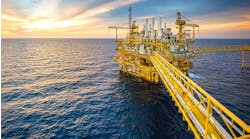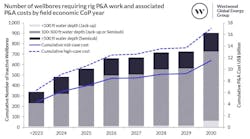Offshore staff
LONDON – Premier Oil has issued more details of contracts for its Tolmount Main gas field development in the UK southern North Sea, announced earlier this week.
The facilities, which will produce around 500 bcf with peak production of up to 300 MMcf/d, will include a minimal facilities platform and a new gas export pipeline to the Lincolnshire coast in eastern England.
Rosetti Marino, which has the EPCIC (engineering, procurement, construction, installation, and commissioning) contract for the platform, is currently placing contracts for the long-lead items.
This includes the award of the contract for the transportation and installation of the platform to Heerema Marine Contractors.
First steel will be cut in December, with the completed platform due to sail from Rosetti’s Ravenna yard in eastern Italy during 2Q 2020, with offshore installation to follow in mid-2020.
Premier and its partners have signed commercial agreements with Centrica Storage Ltd. for upgrades to the Easington terminal which will process Tolmount’s gas.
The terminal was selected as the host facility after the reclassification of Centrica’s offshore Rough gas storage platform as a producing field, which has made gas processing capacity available at Easington on competitive terms.
Saipem is the pipeline EPCI contractor. Landfall construction will start during winter of 2019/2020 ahead of the offshore pipelay campaign in the second half of 2020.
Ensco has a letter of intent for drilling four development wells, the first of which is due to come onstream in late 2020.
Premier has also identified what it believes is significant upside for further reserves in the Greater Tolmount Area. In mid-2019 it plans to drill the Tolmount East appraisal well, targeting a further 220-400 bcf.
The main aim of the well will be to test the eastern extension of the Tolmount field area that sits above the gas water contact but which is structurally separated from Tolmount Main and seen as low risk.
The well would then be suspended for use as a future producer, tied back to the Tolmount Main infrastructure. A successful appraisal outcome could also facilitate tieback of the Mongour discovery, in which Premier also has a 50% interest.
In addition, the company is looking to acquire 3D seismic across the Greater Tolmount Area in 2019 to assist maturation of the Tolmount Far East well location, with a view to drilling this prospect in 2021.
It could potentially add a further 150 bcf, for a probable subsea tie-in to the Tolmount Main field facilities via Tolmount East.
In the UK central North Sea, production data from the Premier-operatedCatcher Area continues to demonstrate good pressure support and connectivity between the reservoirs.
Delivery potential from the wells remains above the FPSO’s design capacity. Premier has started talks with the FPSO provider BW Offshore on sustaining production rates above the currently contracted 60,000 b/d.
The DSVFalcon has tied into production four additional wells, further increasing deliverability from the Catcher Area.
The 17th well, a producer on the Burgman field, was completed this month while the 18th well, another Burgman producer, should be completed in October.
Both wells will then be available for production by November, marking completion of the current phase of the Catcher Area development.
Premier has identified several near-field discoveries as potential subsea tiebacks to the FPSO to maintain and extend plateau production.
Its main focus is on the Laverda and Catcher North oil accumulations: plans here call for two development wells drilled from a common drill center tied back to the Varadero manifold. Project sanction is targeted for early 2019.
In addition, the company has identified potential infill well locations to access resources beyond the reach of the initial producer wells. And it plans to acquire 4D seismic to help define future infill drilling locations.
In February, the company gained two blocks adjacent to the Catcher Area under the UK’s 30th Offshore Licensing Round. One of these is south of the Catcher field and contains the Bonneville discovery, a potential future tieback to the Catcher Area infrastructure.
Elsewhere in this region, production from the Huntington field has been averaging 7,300 boe/d.
A light well intervention vessel has mobilized to the field to initiate conversion of a former production well into a water injector to increase reservoir pressure and enhance recovery.
This should be finalized during 4Q, along with modifications to the subsea pipework.
Premier has agreed to commercial terms with Teekay on extending the Huntington Voyageur FPSO contract to mid-April 2020.
Presently the field is closed for maintenance, including modifications to the FPSO to enable gas import to boost operational efficiency. Production should re-start at the end of this month.
Due to higher commodity prices and stronger asset performance, field life has been extended at Premier’s operatedBalmoral Area (produced through a semisubmersible platform) and at the Kyle field (Premier non-operated, 40%).
Cessation of production from the Balmoral Area now looks unlikely before 2021 while at the Kyle field CNR and Teekay have agreed to extend the lease of the Banff FPSO, which handles Kyle’s production, to August 2019.
Finally, Premier is working on an infill drilling program in 2020 to improve recovery from the central northern part of the Solan oil field west of Shetland.
This will involve drilling a new producer-injector pair targeting known thicker sands in the adjacent Northern Fault Terrace, up dip from the W1 water injector.
The new producer (P3) will be tied into existing subsea infrastructure while the injector will be drilled as a side track from W1. An investment decision should follow soon.
08/23/2018


